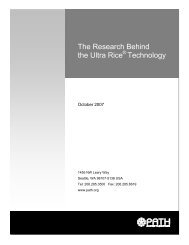STD Management for HIV and AIDS Prevention - Path
STD Management for HIV and AIDS Prevention - Path
STD Management for HIV and AIDS Prevention - Path
You also want an ePaper? Increase the reach of your titles
YUMPU automatically turns print PDFs into web optimized ePapers that Google loves.
<strong>STD</strong>s in the Philippines<br />
Limited surveillance data available in the early 1990s from government Social<br />
Hygiene Clinics (SHCs) 1 suggested high rates of <strong>STD</strong>s in women employed<br />
in “entertainment” establishments registered with the local government. The<br />
data shows the total number of reported <strong>STD</strong> cases in the country rose<br />
from about 47,000 in 1989 to 72,000 in 1991, [2] a change attributed to<br />
better detection <strong>and</strong> reporting following a training program <strong>for</strong> SHC<br />
workers. A few other data sources on <strong>STD</strong>s were available:<br />
• A 1990 study of 1,357 registered sex workers in Manila SHCs<br />
showed relatively high levels of inflammatory <strong>STD</strong>s with 14.5 percent<br />
testing positive <strong>for</strong> gonorrhea, 13 percent <strong>for</strong> chlamydia infection,<br />
5 percent <strong>for</strong> c<strong>and</strong>idiasis, <strong>and</strong> 3.8 percent <strong>for</strong> trichomoniasis.<br />
• A cross-sectional study of 203 antenatal women at the Philippines<br />
General Hospital in 1994 showed 1.2 percent positive <strong>for</strong> gonorrhea,<br />
5.6 percent <strong>for</strong> chlamydia infection <strong>and</strong> 1 percent <strong>for</strong> syphilis. [2]<br />
In 1993, government <strong>STD</strong> services were provided by SHCs, of which there<br />
were about 150 nationwide based primarily in urban centers. Of the female<br />
sex workers diagnosed with <strong>STD</strong>s at government SHCs, an estimated 5<br />
percent received treatment at the SHC, while the remainder sought care at<br />
private clinics or went untreated. [2] Self treatment was common, <strong>and</strong> patients<br />
1<br />
Social Hygiene Clinics, operated by local government health departments, per<strong>for</strong>m <strong>STD</strong><br />
screening <strong>for</strong> registered female sex workers. Although sex work is illegal in the Philippines,<br />
it is not common <strong>for</strong> women (<strong>and</strong> men) employed in entertainment establishments such<br />
as night clubs, saunas, or videoke/karaoke bars to offer sexual services to customers<br />
during or after work hours. These women are commonly known by such terms as<br />
“hospitality workers” or “guest relations officers.” ASEP refers to them as registered female<br />
sex workers (RFSWs). Freelance female sex workers (FFSWs) work on the street or in<br />
unregistered establishments.<br />
<strong>STD</strong> management <strong>for</strong> <strong>HIV</strong> <strong>and</strong> <strong>AIDS</strong> prevention<br />
5

















